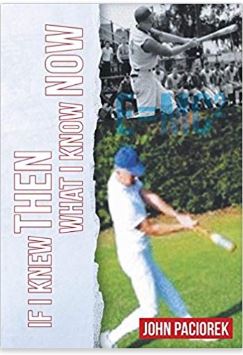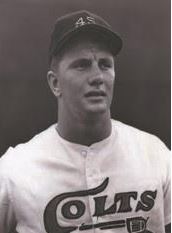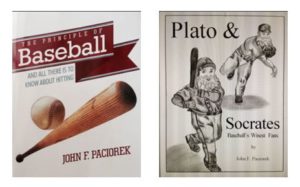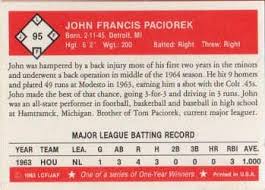 IF I KNEW THEN WHAT I KNOW NOW
IF I KNEW THEN WHAT I KNOW NOW
By John Paciorek
Page Publishing, Inc., 2018
Available in print or electronic form. It can be found/ordered at bookstores, or online at the Apple iTunes store, Amazon, Google Play, or Barnes and Noble.
FIELDS OF DREAMS
Most baseball fans share a “dream” – getting that one appearance on a major league mound or in an MLB batter’s box. You know, getting that notation, no matter how short, in The Baseball Encyclopedia. If I Knew Then What I Know Now is about a different kind of dream. The kind of dream that drives a player who made it to the big leagues (if painfully briefly) – the dream of rising toward true perfection as a ballplayer. Baseball Roundtable
Let’s get one thing straight right from the start; If I Knew Then What I know Now is not your typical baseball book. Even author John Paciorek says he would assign it to a newly coined genre – “semi-autobiographical fiction.”
It is generally acknowledged that John Paciorek had
the most successful one-game MLB career in history
It is also not written by a typical baseball player – more on the baseball playing part of that observation in a minute, but first a look at the “writing” side of this baseball story.
I mean, seriously, in what other book would you find a former player (or even a sportswriter or biographer) correctly and effortlessly using the term “equipollence” in describing a batter’s swing or in what other baseball book would you find a chapter headed “Einstein’s ‘Home Run’ Principle”?
Ultimately, If I Knew Then What I Know Now is both thought-provoking and thought-requiring. Oh yes, and the chapters are best read in the order they are presented.
A “THOUGHT” FROM BBRT’S INTERVIEW WITH JOHN PACIOREK
“Nothing productive happens without thought. ‘Thought precedes action’ is an expression with which most people will concur, at least until they are asked to delve deeply into its true practical significance. Throughout my book, reference is made to ‘physical prowess’ that is enhanced only as it proceeds from conscientious thought.
The book is unique in its approach because its principle lays a foundation that supersedes that standard batting protocol of ‘See ball, hit ball.’ For example, ‘Einstein’s Home Run Principle’ offers this approach ‘Most analysts subscribe to the notion that a batter must be extremely strong to be a consistent home run hitter. While strength is an asset, mechanics play a more important role! If a person can hit one home run, he can hit seventy or more, if all the required conditions are present every time.’ I would add that those conditions include both the physical (mechanics) and mental approach to the at bat.
I believe that, gradually, this book will become the ‘standard textbook’ for ultimate baseball success.”
This review – like the book – will not be typical. It will include notable excerpts from the book and finish with an interview with Paciorek, looking in more detail at the principles he brings forth.
In the book, Paciorek describes his pursuit of his dream of perfection on the baseball diamond as a combination of the physical and metaphysical. He delves deeply into the physical aspects of the game, detailing the mechanics of building the perfect swing, laying down the perfect bunt or making the perfect pitch. He also looks, perhaps even more in-depth, into the mental aspects of reaching for perfection on the ball field – the power of positive thinking; mind/body balance; visioning; patience and expectations; and perfect practice. Clearly, Paciorek is a dedicated student and teacher of the game.
Along the way, Paciorek cites a diversity of personal influencers – a range that stretches from:
- Baseball’s Ted Williams and Mickey Mantle; to
- Martial arts’ Bruce Lee; to
- Philosophers Socrates and Plato; to
- Christian Scientist Mary Baker Eddy; founder of chiropractic D.D. Palmer; physicist Albert Einstein; and the teachings of Abraham (Law of Attraction).
Note: I must admit, at times I had to make the effort to further familiarize myself with the work of these influencers in order to better understand Paciorek’s message.
Paciorek delivers his message from the “stage” of 1964 baseball Spring Training – and the scenes are populated by such characters as: Paciorek himself; teammates like Jimmy Wynn, Walt (No-Neck) Williams, Rusty Staub and Joe Morgan; and opponents like Mickey Mantle, Don Drysdale, Dick Allen and Casey Stengel. And, Paciorek illustrates the impact of his “influencers” with plenty of baseball action on the field and in the club house.
Excerpt from If I Knew Then What I know Now …
The Scene: John Paciorek batting against Whitey Ford in Spring Training.
I saw an uncommon sense of frustration (probably in himself) on the face of Ford, so I knew he didn’t want a “rookie” to be a “hero” in this situation. He was a “hard-nosed,” as well as “smart,” pitcher.
Sure enough, his first pitch to me was a fastball, high and tight. I’d guess he would have expected a rookie to hit the dirt. Just before the pitch, catcher Elston Howard said, “Be alert!”
From my low and quiet stance, I could see clearly the release point of Whitey’s pitch. It started inside and never deviated from its straight-line trajectory. It was about shoulder high, so from my slightly “leaned-over” position, I simply leaned back and watched the ball skip past my left shoulder.
As the pitch was coming, Elston yelled, “Down!”
After he reached to his left to catch the ball, his eyes indicated a surprised look that I hadn’t “hit the ground.”
No need for me to panic – from my low and stable stance, I saw the ball clearly, and casually leaned back to avoid it.
The book can be a bit of a roller coaster ride – or more aptly “roller coaster read” – and, as I noted early on, it is both thought-provoking and thought-requiring (with some fun and considerable insight into the national pastime to be had along the way).
IF I ONLY KNEW THEN WHAT I KNOW NOW …
Going back to the source can explain how Paciorek got to the destination that resulted in this book.
John Paciorek grew up in what he describes in the book as a “low-middle-income, Polish-Catholic” Detroit neighborhood. He also grew up in a baseball family – John and his brothers Tom and Jim made it to the major leagues. Young John Paciorek emerges as an individual driven towards perfection in all endeavors – capable of dedicating himself (sometimes) to a fault to being not just one of the best, but the very best, every time he took to the competitive field.
John Paciorek’s drive got him onto a major league field by September 29, 1963 – at the age of 18 – for the Houston Colt .45s (that‘s what they were called then). Batting seventh and playing right field, Paciorek had an auspicious debut. In addition to four errorless outfield chances, he racked up five plate appearances, three hits, two walks four runs scored and three RBI. As surprising as his debut major league performance is the fact that the game also represented Paciorek’s major league finale. It is, in fact, generally acknowledged that John Paciorek had the most successful one-game MLB career in history (a 1.000 batting average; on-base percentage; slugging percentage; and fielding percentage). That assertion is successfully chronicled in Steven K. Wagner’s book – Perfect: The Rise and Fall of John Paciorek, Baseball’s Greatest One Game Wonder.
What happened? Paciorek’s major league potential was cut short by a back injury that required surgery in 1964, sidelined him for all of 1965 and limited him to four minor league seasons going forward.
As you move through If I Knew Then What I know Now, you see how Paciorek’s Polish-Catholic upbringing, sports-oriented (particularly baseball) family, relentless pursuit of perfection and brush with greatness laid the foundation for this book. Paciorek’s life after professional baseball provided the finishing touches to that foundation. He earned degree in physical education from the University of Houston and enjoyed a long career – retiring in 2017 – as a physical education teacher.
Paciorek has written two previous books: Plato and Socrates, Baseball’s Wisest Fans and The Principle of Baseball and All There is to Know about Hitting. He also has a blog at www.johnpaciorek.com
A final observation from the pages of
If I Only Knew Now What I Knew Then ….
Center field was the easiest of the three outfield positions to play because you can see the batter-pitcher relationship most clearly and directly … The angles of vision were not as direct in right and left fields.
—–THE JOHN PACIOREK BASEBALL ROUNDTABLE INTERVIEW—–
BBRT: What prompted you to write the book – and is there an overriding message (about baseball and/or life) you would like readers to come away with?
JP: Steve Wagner’s book (Perfect: The Rise and Fall of John Paciorek, Baseball’s Greatest One Game Wonder) was so well written, but I knew he didn’t have the information that would complete the story. So, I was inspired to offer a new and more complete version. A consistent message across the book’s pages is that in baseball and in life, always remember that no matter how poorly your day may have gone, you always have tomorrow to resurrect and reestablish your formidable prospectus.
BBRT: If you really did know then what you know now, is there something you would have done differently in 1963-64?
JP: I would never have had the back operation that ended my major league career. The book explains why!
BBRT: Can you describe, for those of us who will never realize that dream of a big league at bat, the feeling when you first stepped to the plate in an MLB game?
JP: My experience may have a different tone and feel to it than that of Moonlight Graham – as portrayed in Field of Dreams. Here again, I’d go to an excerpt from the book, this one describing my first major league plate appearance.
“With utmost confidence, Johnny stepped into the right-handed batter’s box. He’d been there before – not only in his mind, but in big-league Spring Training camp. It’s not going to be any different. I hit ‘em then. I’ll hit ‘em now. ‘This is where I belong, here I’ll stay’ were the thoughts resonating through his mind.”
The fact is, I was excited, but also “cocky.” I thought I belonged in that setting, so I wasn’t nervous or intimidated, just ready to do something good. I walked. The rest of the story of my major-league day is found in Chapter Four.
John Paciorek’s “View” on Baseball, Teaching and Life (and even physics)
Change the way you look at things, and the things you look at change.
The preceding principle, made practical by Dr. Wayne Dyer applies to physics, baseball and general education. Physicists Albert Einstein and Max Plank proved that merely observing a particle of light changes its composition and position in space. Expanding the application of that concept, a teacher who views a particularly poor student from a more positive perspective will see improvement in that student that an otherwise negative view could not have imagined. And, a baseball batter, who assumes a low and stable stance, with little or no head and eye movement, will see the “descending:” pitched ball more clearly, enabling a better approach to hitting it. Conversely, a less stable stance – and, therefore, less stable way of seeing the ball, will detract from a hitters’ potential.
BBRT: What is it that most attracts you about the game of baseball?
JP: I think an excerpt from the last chapter of the book says it best: “Baseball’s enduring attributes, to all levels of civilized society, are those which foster relevance to equal opportunity for the individual and a sense of genuine contribution to a collective effort. Every player in a lineup bats. Every position is held equally accountable for mental and physical errors. The same standard for all players! What can be a fairer way of evaluating performance? Is there any other arena in “sports” that epitomizes the universal “American Experience” more than that displayed on baseball’s level field of play?”
BBRT: Is there any specific piece of advice you think is most important when it comes to the mechanics of hitting?
JP: In my first book (The Principle of Baseball: And All There is to Know About Hitting), I expounded on the Principle of Simplicity. To make hitting a baseball simple, a batter must remove many or all of the margins for error that would prevent the batter from effectively contacting the ball with the bat.
The foremost advantage for attaining a mechanical advantage in hitting a pitched baseball is clarity of vision. Thus, the more stable the batter’s head and eyes, the clearer the focus on the moving ball. Whatever the length of a batter’s stride, the head and eyes are moving to that same degree. If a batter wants to be as perfect as possible in the approach to hitting a baseball, that batter should eliminate the stride. My first book and posts on my website go into more depth on all the margins for error in a hitter’s swing, and provide further explanation for those who cannot fathom eliminating the stride.
BBRT: From personal observation, who are the most “perfect” hitters you have ever seen?
JP: First is Barry Bonds. Second is Ted Williams. Both Aaron Judge and Giancarlo Stanton have the potential to be among the greatest ever, if they altered one aspect of their batting mechanics. I go into some detail on both Judge and Stanton in posts on my website at johnpaciorek.com
BBRT: You built a long career as a teacher and coach. What did you find most satisfying about that part of your life? And is there a coaching/teaching philosophy you could share?
In the most straightforward of terms, it would be that “Teaching is a constant learning process – for both teacher and student.”
I actually present that teaching philosophy in the new book. At one point in the story, Plato and Socrates are heard reading a treatise by a mysterious extrapolator of wisdom: “Education is a circular evolution of thought, whose cultivated experiences are predicated on learning and teaching, and teaching and learning. To teach is to learn. Teacher and learner are the same. To teach is to demonstrate what I learn and believe. Teaching is a constant learning process. From my teaching demonstration, others learn, as well as I. It is in constant learning that teacher and learner are the same.
BBRT: One – and only one – big league game. Are there any regrets from the standpoint of would it have been better not to taste that “major league fan adulation” if it was going to be a one-game experience.
 How can you regret realizing the big-league dream? Just as that old-saying might be paraphrased: It is better to have fought and lost than to have never fought at all. But, in my situation, It is better to have fought, even if never to fight again, than to have never fought at all.
How can you regret realizing the big-league dream? Just as that old-saying might be paraphrased: It is better to have fought and lost than to have never fought at all. But, in my situation, It is better to have fought, even if never to fight again, than to have never fought at all.
Then, of course, there is the game itself – and records that will probably never be broken. How could it ever be imagined that someone would make their MLB debut in the last game of the season, play the field flawlessly, bat five times, collect three hits and two walks, score four runs and drive in three – and then have an off-season back operation that would prevent him for every playing in the big leagues again.
________________________________________________________
Baseball Roundtable’s John Paciorek Award
In 2014 BBRT launched its annual John Paciorek Award, recognizing players who had brief – but in some way significant or notable – major league careers. To check out the stories of those recognized, use the links below.
2018 … Keith McDonald here.
2017 … Chris Saenz here.
2016 … John Allen Miller here.
2015 … Roy Gleason here.
2014 … Brian Dallimore here.
I tweet baseball @DavidBBRT
Follow/Like the Baseball Roundtable Facebook page here.
Member: Society for American Baseball Research; The Baseball Reliquary; The Negro Leagues Baseball Museum.








